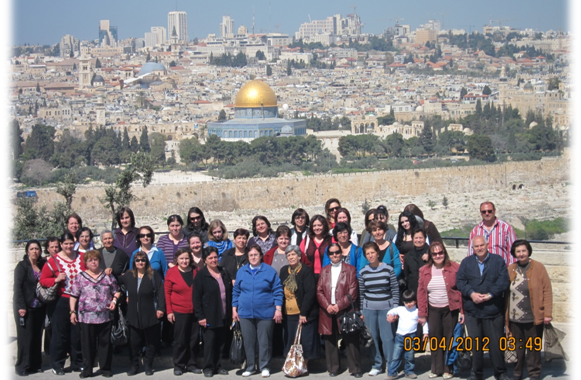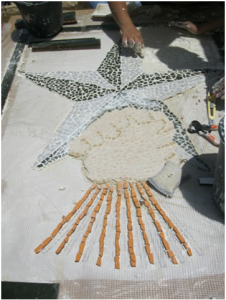Report
Ecumenical women project
Submitted To: World Vision
Submitted by: Wi’am Palestinian Conflict Resolution Center
Period:
Piece of Art done by Wi’am’s children
Report
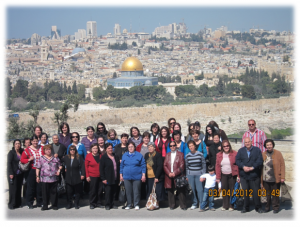
The Ecumenical women project is an opportunity for women from different congregation from Bethlehem area to be together through engagement in two intertwined activities: firstly, Ecumenical meetings and presentation by academics on issues related to the Christian presence in the Holy Land such as immigration, canon Law and Ecumenism. In these meetings, women engage in learning discussions on their identity, intra-Christian relations, Problems they face and ways of enhancing intra Christian relations and ways of empowering family ties and Christina identity. These meetings are considered an opportunity and an open space for different congregations to exchange ideas about issues of concern and a space for open and frank discussions about ecumenical relations and the different aspects of canon Law, orienting the participants about different laws, such as inheritance, social code, divorce, marriage, divorce, custody …etc.
Another part of the project is raising awareness of the Christian women about the historical and religious sites through organizing two trips to Holy Sites in Jerusalem and Galilee. The objectives behind these trips are to acquaint the participants on the historical background of the religious sites and its significance to their life, identity, heritage, citizenship and faith at the same time. These trips are an integral part of the Christian faith as they connect the Living Stones to the theology of the Land in the physical locations that are great significance to them.
These meetings are interactive and synergic, the participants had been leading the discussions and responsible for putting recommendations and ideas on ways enhancing the Christian identity in the Holy Land and future activities.
Christian Emigration
Presented by: Dr Adnan Musalam
Dr. Adnana , a specialist in Local Christian immigration, give a chronicle about the history of Christian emigration and how Britain, the mandatory power over Palestine, played a leading role in preventing Palestinians from returning home from the Diaspora in Latin America in the 1920’s.. a negative reaction, that of anxiety and fear, took place in the Christian Arab community. As a result, there are two trends in the Christian Arab community of Bethlehem: First, there is a majority trend, which sees the local Christian as an integral part of the Arab majority and Palestinian Arab collective identity, which is deeply rooted in the lands of Palestine.
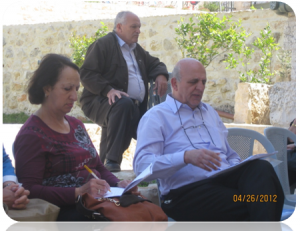
On the other hand, on the fringes of Palestinian society, there are zealots, both Christians and Muslims. On the Christian Arab side, there are some fears and anxieties resulting from the rise of Islamic fundamentalists in the community and the nation. Some exploit these fears and anxieties by constantly telling the individual that he/she is a member of a religious minority. This “minority mentality” is clearly destructive, leads only to alienation of the individual from his /her fellow Palestinians and from the land of Palestine, and only invigorates the phenomenon of emigration.
Dr. Adnan talks about the negative phenomenon of Christian emigration from Bethlehem and the Holy Land in general. He gives gloomy figures about the extent of Christian Arab presence using the latest Palestinian current census figures. He focused on challenges facing the Palestinian Christian family and the driving force behind their immigration to the West looking for better life and hope for their family and children. He emphasizes the role of family networks of Palestinian Christians throughout the world and their role in luring their families to immigrate. The speakers talks about the disappearance of large number of family names in Bethlehem and Beit Jala only to reappear in Latin America, i.e. in Chile, Columbia, Honduras, etc……
Wiam’s women played a leading role in questioning the lecturer as well in clarifying some issues and some talked about the emigration of their relatives. It was clearly felt by all that the phenomenon of Christian emigration, if it continues; it will only lead to a disaster to Palestinian presence in the Holy Land. Dr. Adnan gives some ideas:
- The hardship of the Palestinians is the same for both Muslims and Christians, but the Arab-Christians as a minority finds themselves more vulnerable than their blood brothers the Arab-Muslims who form the majority.
- Christians are under hardship because of the Israeli Occupation and the policy of Closure and they are emigrating in an alarming scale.
- In Fact: The Holy Land and especially in the Occupied Territories and the Palestinian Authority see a terrifying decrease in the Christian Presence: Christians (Catholic, Orthodox and Protestants) are about 2.5% in Jordan they are 1.8% in Palestine and Israel.
- Entire families after the six-day war and the Oslo agreement are leaving the Holy Land. Fr. Majdi pastor of Beit-Sahour, Bethlehem, have given the example of his parish Beit-Sahour who lost only in 1998, he said, out of 290 families 63 families who immigrated for good to the USA, Canada and South America. Jerusalem out of 10.000 families some years ago they are now less than 5.000 families. In Bethlehem area Christian are about 25.000 families, when in the USA and South American they are more than 250.000. Several analysts predict that the Holy Land will become a museum of Christian Site with no Christian presence on the year 2025 if the scale of Christian immigration continues and if the Christians of the Holy Land do not find any support for their cause from their Christian and Muslim brothers c- THE REASON behind this alarming situation in Palestine and Israel are:
1- The hardship of the Israeli Military Occupation of the West Bank and the weak of law on the territories under the Palestinian Authority.
2- The Closure of the Occupied Territories and the Territories under the PA. Israel does not permit to Palestinians to go to Jerusalem and with great difficulties; they connect between the different cities under P.A. The Closure makes it as a big jail for Palestinians
3- An International Monetary Fund study found that the real GNP per capita among Palestinians has fallen 22% since the signing of the Oslo Accords, and stands now at $1.700 annually, one-tenth the Israeli level ($17.000). This was the statistics of the year 1999. Today the Palestinian with the actual Israeli government have lost a lot of their infrastructures, their olives, lands, work and became the poorest people in the Middle East.
4- The unemployment went up after the Oslo agreement and specially the last five years from 13% to around 20%
5- The confiscation of Lands by the Israelis, Houses, Palestinian Ids, demolition of houses, building of Settlement increased after Oslo accords and made the life of the Palestinians impossible. The Christian Minority was the most vulnerable. I have the largest Catholic Palestinian parish in San Francisco. Yes, in San Francisco, California and not in Palestine.
Topic: Canon Law
Presented: Alfred Rock
Having welcomed the audience, Rock, talk about the Canon law is the body of laws and regulations made by or adopted by ecclesiastical authority, for the government of the Christian organization and its members. He identified in the roundtable discussion legal norms applicable at ecclesiastical courts as well as relevant practical problems of implementation. In addition, Rock pointed out the fact that there are certain elements in canon law borrowed by the Church from civil law or from the writings of private individuals, who as such had no authority in ecclesiastical society. Canon law is also called “ecclesiastical law”, however, strictly speaking, as he says; there is a slight difference of meaning between the two expressions: canon law denotes in particular the law of the “Corpus Juris”, including the regulations borrowed from Roman law; whereas ecclesiastical law refers to all laws made by the ecclesiastical authorities.
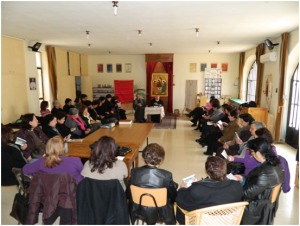
In his presentation, Rock talks about SOURCES OF CANON LAW: this expression has a twofold meaning- it may refer to the sources from which the laws come and which give the latter their judicial force; or it may refer to the sources where canon law is to be found, i.e. the laws themselves such as they occur in the texts and various codes. These sources are also called the material and the formal sources of canon law. The ultimate source of canon law is God, Whose will is manifested either by the very nature of things (natural Divine law), or by Revelation (positive Divine law). Positive Divine law cannot contradict natural law; it rather confirms it and renders it more definite. The Church accepts and considers both as sovereign binding laws, which it can interpret but cannot modify; however, it does not discover natural law by philosophic speculation; it receives it, with positive Divine law, from God through His inspired Books, though this does not imply a confusion of the two kinds of Divine law. Other sources of law are rather impersonal in their nature, chief among them being custom or the unwritten law, or even customary law, resulting from practice and custom
The speaker indicated also that the laws established by their respective churches govern Palestinian Christian women. He talked about the Divorce: in general the Orthodox Church permits divorce if a woman is found to be unfaithful, refrain from getting pregnant, is found not to be virgin upon marriage, or refuses to obey her husband in a dispute for a period of three years after being instructed to do so by the church. The Catholic Church, on the other hand, offers no possibility for divorce, but annulment is possible if the marriage was contracted with legal flaws, men and women enjoy exactly the same rights in this respect. Because the Catholic Church allows only a separation when spouses have a conflicting dispute, where as the Orthodox Church has granted divorce in such cases, some Catholics have converted to Orthodoxy to obtain a divorce. Protestant church law allows a divorce if one of the spouses is found to be adulterous and the husband and wife do not engage in sex after the adultery is revealed. When the marriage is ended in this way of the spouses is able to marry again.
The roundtable discussion involved two major components: (1) sources of legal norms and (2) practical problems encountering ecclesiastical courts, especially in respect of limitation of succession cases, bank transactions and execution. He explained sources of legal norms applicable at ecclesiastical courts. As recognized juridical persons, ecclesiastical courts refer to several legal sources, including the Code of Canon Law, Law of Personal Status of 1954, Ecclesiastical Jurisprudence, ecclesiastical decrees and instructions, as well as PA-promulgated laws that regulate functions of ecclesiastical courts. He also highlighted practical problems and predicaments that face ecclesiastical courts.
However, the second issue we face according to the speaker is the need for a right understanding of when to resort to canonically based actions. Participants discussed topics raised in the roundtable meeting and made several recommendations. Discussants asserted that similar events should be organized to address various themes relating to ecclesiastical courts in Palestine.
At the end of the meeting, many women raised different questions and brought around cases that women face in issues. One of cases raised by a participant is the issue of divorce between divorce and Orthodox as she passed through this experience before.
Topic: Ecumenisms
Presented by:Yusuf Daher
Yusuf spoke about some elements that need to be considered: the Holy Places, the relations between hierarchies, and those between the faithful of different denominations. As for parish priests, that all depends above all on individual priests. There are meetings above all characterized by a spirit of brotherhood between different denominations, and that is very important. The participants’ discussed different subjects and asked questions that revolve around shared problems and difficulties that are generally external and often related to the situation in the country- for example: problems facing the unification of Christian holy celebrations, relations between different congregations and priests, access to Jerusalem, freedom of movement for Christians. It is more challenging for them to broach subjects related to problems that there between churches, i.e. cleaning the church of nativity. They are able to adopt a united position when there is a sensitive issue related to the relations between churches, However, we have the impression that it’s hard for them to approach these topics them directly as they think that the upper hierarchy of the church has the key.
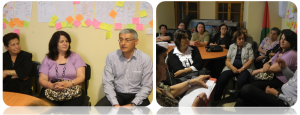
I think, Yusef adds, and this is a sociological phenomenon you will generally find in the Middle East – that the faithful identify more easily as Christians, whereas the clergy identify more with their denominations. For the faithful, what mostly counts is solidarity with other Christians in the presence of non-Christians, and they spontaneously collaborate with each other. The speaker gives examples that look at how many Orthodox teachers there are in Catholic schools, how many Orthodox members and assistants there are in social organizations like Caritas, and how many are involved in youth movements (the Scouts, the YMCA, the YWCA, etc.). Everywhere we see Catholics, Orthodox, and Protestants working together, he adds. The participants agree with him that almost every family participates in this type of interaction. That really helps with the spontaneity of collaboration, which Christians feel is vitally important for their presence. Sometimes they say, “Unity is not an issue. The only thing that still separates us is holiday dates.” That is a little simplistic, but that is how they feel.
Therefore, despite the accusations that are made against the church in Jerusalem – against all the churches – ecumenism is alive in the Holy Land. When people say that division between churches is a scandal, particularly in Jerusalem, where Jesus prayed for the unity of his people and so on, I agree, but I hasten to add that none of the divisions we face originated here. They were all brought in from “outside”. Therefore, the church is not responsible for them, but it suffers their consequences. It would behoove pilgrims, who claim to be scandalized by the existing divisions, to be well aware of this.
Spiritual Trips in the footsteps of Jesus: Awareness of the place and religious significance
On this extraordinary journey, participants visit many of the most sacred sites to Judaism, Christianity and Islam: wander the storied streets of Jerusalem, visit Bethlehem, participants benefit from the wisdom of trip leaders. At each stop, tour leader provide the participants’ with knowledge of the history and contemporary significance of the holy Land sites. From exploring the history of the Holy sites in Bethlehem, Nazareth, Galilee, participants leave with a profound and nuanced understanding of the cultural, geographic, and spiritual legacy of the fascinating land. As the tour title suggests, many of the first-century conditions that shaped Jesus’ life and ministry continue to shape the lives of Palestinians today. In addition to exploring the holy stones – the historic places and sites that have defined our faith – participants, as the Living Stones, explore their identity, heritage and their life in the land.
Part of the effort to enhance the Christian identity in the Holy Land, Wi’am organized two excusing to Holy sites in Galilee and Jerusalem. The women group in the project embarks on purposeful and enriching journey of discovery of their land, history, identity, roots and their active role in their community as active citizens. The group interacted in a positive way with the explanations and information that the tour agent shared with them and they have sufficient time to listen, reflect, and pray during their visits. People have been learning new facts and knowledge about the Holy sites that they heard for the first time despite that they are born in the area.
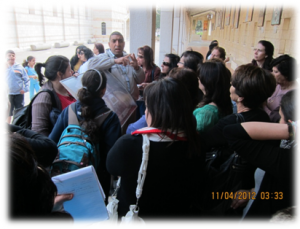
The visit to the holy sites help the participants to identify with their roots; it is a message to come and see the heritage of the early church and an exploration of the role of the congregations as well as different churches as carriers of cultural and religious attachments to the Land. It is to them a journey to find deeper truths about themselves and the meaning of Christian faiths; they are transformed so that they feel that they fulfill the will of God Who entrusted us to the Land and in keeping the mantle of faith
Participants explored the holy sites of Jerusalem and Nazareth; visit diverse Holy places:
- The Golgotha, the Church of the Holy Sepulcher, Jesus Tomb, and the Church of All Nations, the Last Supper, Olives Trees in Gethsemane. Saint Peter, Via Della Rose.
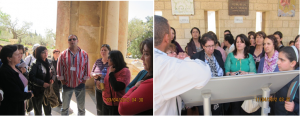
- Sea of Galilee Church of the Annunciation in Basilica and Mary’s Well in Nazareth , which is believed to be Jesus’ hometown, and the site of other holy places. Dome of the Ascension
Participating benefited the following:
- Become more aware of their cultural and religious traditions that exist and how they shape their lives.
- Learn new information about holy sites and it’s spiritual/historical significance in their life, helping them gain understanding and enforce their Christian identity
- Participants learn accurate and useful information that covers the religious, social and cultural dimensions of the holy sites in Palestine.
- People recognize more the historic roots of their identity and its impact on their presence in the HL as active citizens
Recommendations:
Being in the Holy Land and in the midst of the current socio-political climate is a challenging situation to many families. The program is an extraordinary opportunity for Local Christians to experience their identity, history, tradition, roots, life, aspirations and religious significance of holy sites. The activities in general help people put a meaning, a smile, and a solidarity message that together we grow in our faith.
We strongly believe that that such programs need to be implemented on regular basis to give chance to more women from diverse congregations to participate and learn. From our observation and feedback from the participants, we sense the urgent need to offer support and invaluable learning opportunities to women from different congregations. People from different congregations are less aware of the significance of their active presence in the holy Land; they need to gain the right knowledge and learning about the Christian roots and their role as indigenous people with valuable presence in the land. To empower the Christian presence in the HL, People need to learn about their Christian roots, the significance of holy sites to their life and how their national and Christian identity is a valuable asset in their life and the community at large.
Please allow me some of the feedback from the participants on the impact of the project:
- Lauret from Bethlehem, I have a deeper understating of Christian identity and I have better knowledge about the perspective of the Canon Law towards inheritance and divorce
- Jala from Beit Sahour the presentation of the ecumenism gave us a chance to discuss issues related to inter domination relationship and the problem of Unifying religious holidays
- Nadia a woman from Beit Jala commented on the presentation saying the presentation about the Immigration opened my eyes to new facts about the Christian presence in the Holy Land and the need to go against this trend
- As the women groups are from the beginning encouraged to express their attitude and engage in constructive discussions, they acquire the potential to continue their own work and follow-up the project after project phase-out. Wi’am plans to integrate the target group into its own women empowerment activities through diverse activities and meetings that will enable women to pass their knowledge and learning to other women in different areas of the West Bank. These groups will be an integral part of wide gatherings of different congregations that help create wider networks and reach more areas creating better dialogue, discussion on congregational issues, and disseminating knowledge they acquired on holy places, immigration issues and ecumenical issues of interest.

